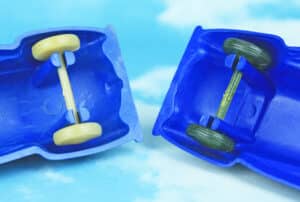Cruver: Twin Sons of Different Mothers
by Douglas R. Kelly

Early plastic toys run the gamut in terms of quality. Some were well designed and well executed, while others obviously were made more with cost savings in mind than beauty. Cruvers fall into the first category.
The Cruver Manufacturing Company was located in Chicago, IL, and during World War II, produced products such as navigational tools for ships and planes, along with recognition models, made from a variety of plastics. Following the war, the company turned its attention to household items, such as cases for decks of playing cards, as well as cases for toy cars. For years, the only Cruver product I was aware of was a beautiful plastic promo model of a 1949 Oldsmobile 98 sedan, about 8 inches in length and just about impossible to find in decent condition as survivors tend to have warped bodies. In fact, I’m still on the hunt for one after more than 20 years.
But my friend and fellow plastic collector Ben Kriner surprised me probably 7 or 8 years ago at a toy show when I picked up a blue plastic toy car from his table and began examining it.
“That’s Cruver, of course,” he said matter-of-factly. “It is?” I replied. “But it’s not an 8-inch Oldsmobile.” Ben told me Cruver made some smaller toys, as well. The blue car was 5.25 inches in length (that’ll be important a bit later) and was a two-door coupe despite being long enough to have rear doors had the maker chosen to add them. There was no maker’s mark or identification anywhere on the toy.

The front grille had to be based on a Buick of the late 1940s, which is about when the toy must have been made. It sported unusual cream-colored wheels, which although not realistic, gave the car a vintage look that was kind of perfect. There was no way I couldn’t buy this toy, so Ben and I did the transaction. And that Cruver sat in my display case, alone among the Ideal and Marx and Irwin toys, flying the Cruver flag all by its lonesome, until a month or so ago. While doing an eBay search on vintage plastic, the Cruver’s twin popped up on my screen. At first, I assumed it was a similar model that Irwin made, but that extended “fastback” roofline jumped out at me, and I thought, “That’s a Cruver!” I studied the photos as closely as I could, decided it was a Cruver, and bought it.
When I unpacked the car, I could see that it was a deeper, richer shade of blue than my first Cruver. I placed the two together and saw that the new acquisition was slightly smaller than the first one, measuring 5 inches compared to the 5.25 inches of the first example. That in itself meant it’s likely a close copy of the Cruver; add to this the fact that, while some details are essentially identical, there are others that are obviously different, and we have a mystery on our hands – the kind I love to try to sort out.
The second car, like my first, is unmarked, and it also has unusual wheels: a translucent green color that, for some reason, just works with the body shape. They look for all the world like round cough drops, although I’ve no idea what kind. Buick flavor, I suppose.

Why would another maker copy the simple (although charming) one-piece Cruver? Generally speaking, copies (or knock-offs or repros) of toy cars most often were based on more expensive and more detailed products like Dinky Toys or Corgi Toys, or on plastic toys like the large wind-up Saunders convertible (see my article on toy convertibles in the last issue of the Journal for more on that one).
Could making new tooling and producing a copy of a low-priced toy like this have offered any kind of profit margin?
The seller of the second car, a collector in Florida, shared with me a picture of a red version, as well as a tan version that has a hole cut into the grille, into which a small lightbulb can be placed, powered by a small battery. Now I have other colors to hunt for along with an “electric” version, courtesy of my new friend.
Douglas R. Kelly is the editor of Marine Technology magazine. His byline has appeared in Antiques Roadshow Insider; Back Issue; Diecast Collector; RetroFan; and Buildings magazines.


